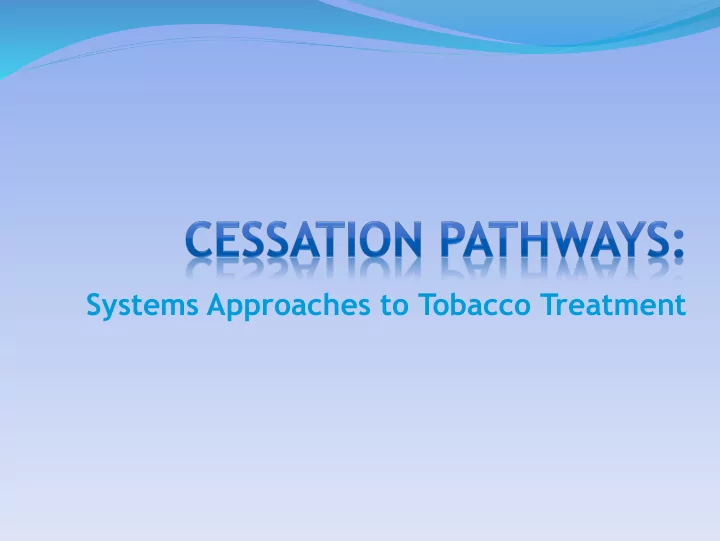

Systems Approaches to Tobacco Treatment
Session Objectives Highlight the burden of tobacco use in Colorado Review Colorado QuitLine program fundamentals, including access, eligibility and service delivery Understand the critical role of providers on impacting quit attempts and cessation success
Framing the Problem 15.7% of Coloradans currently smoke Only 68% have been advised to quit by a physician 38.6% of adult smokers in CO were referred to smoking cessation treatment Smokers who are advised to quit attempt quitting at higher rates
Disparities Snapshot Low SES Uninsured and Medicaid members Adults <65 years Native American & Black LGBT Unemployed & unable to work Persons with behavioral health conditions
Portrait of a Current Smoker Less likely to have a regular provider Less likely to have annual wellness visit and be up-to- date on preventive services Less likely to meet nutrition and physical activity recommendations More likely to be diagnosed with COPD, arthritis, cancer, cardiovascular disease, and depression
The Impact of Provider Advice Compared to people who smoke who do not get help from a clinician, those who get help are 1.7 – 2.2 times as likely to successfully quit for 5 or more months 1 . 1 Fiore et al. (2008). Treating Tobacco Use and Dependence: 2008 Update.
Evidence-Based Interventions Evidence-based tobacco dependence treatment: 2 Psychosocial interventions Behavioral counseling Tobacco Cessation Medications 2 Final Update Summary: Tobacco Smoking Cessation in Adults, Including Pregnant Women: Behavioral and Pharmacotherapy Interventions. U.S. Preventive Services Task Force.
Tobacco Use Standard of Care All patients should be ask ed if they use tobacco and should have their tobacco use status documented on a regular basis All physicians should strongly advise every patient who smokes to quit because evidence shows that physician advice to quit smoking increases abstinence rates Every tobacco user should be offered at least a minimal intervention and refer ral to evidence-based treatment, such as the Colorado QuitLine
This section will highlight current QuitLine QuitLine benefits and accessibility options for Service Delivery Basics Colorado residents.
Why QuitLine? Access Quality Coordination QL works in QL can QL increases conjunction provide the access & with treatment reduces physician intensity that barriers, intervention often cannot including those and provides be provided related to: cost, feedback on in a clinical travel, language client setting due to & business progress. time hours. constraints .
The Colorado QuitLine How To Reach Us Features 1-800-QUIT-NOW Intensive, client-centered coaching 1-855-DEJELO-YA Confidential 1-800-659-2656 (TTS) Non-judgmental www.coquitline.org Free NRT Self-help materials Text-messaging and email support
Eligibility ▪ To enroll, caller must be: ▪ a Colorado Resident ▪ 15 years of age for the coaching program ▪ 18 years of age to receive cessation medication* *Provider consent is required for individuals self-reporting uncontrolled hypertension, heart attack or stroke occurrence within the past calendar year; and for pregnant and breastfeeding women
Access & Enrollment ▪ Participants can enroll by ▪ Phone (1-800-QUIT-NOW) ▪ Provider Referral ▪ Online (COQuitLine.org)www.coquitline.org ▪ 7 day per week, Multilingual Call Center ▪ 5 am to 11 pm MST ▪ Voicemail available 24 hours ▪ 5 Call Program ▪ Up to 5 Coaching Calls (Outbound at scheduled times) ▪ Unlimited inbound calls for support
Pharmacotherapy Protocol Every CO participant (18 or older) enrolled in coaching is ▪ eligible for 2 quit attempts and 2 courses of nicotine replacement therapy (NRT) per 12 months*. ▪ Clients must maintain enrollment in the coaching program to receive additional medication shipments. *A client's calendar year begins on the date of their first QuitLine medication order.
Nicotine Replacement Therapy Colorado QuitLine NRT ▪ Patches, Gum and Lozenges ▪ Combination Therapy available ▪ Up to 8 weeks of NRT available twice/year ▪ Shipped directly to the participant’s home
Nicotine Replacement Therapy ▪ Monotherapy ▪ Patch, gum, or lozenge offered (one product) ▪ Course of therapy delivered in two, four week shipments ▪ Combination Therapy 6 weeks of patch plus short acting NRT (gum or lozenge) and one additional 2 week course of monotherapy (client choice of product).
Chantix Benefit Details Standard course of Therapy ▪ Clients are eligible to receive one* 12 week course annually ▪ Provider prescription is required and faxed direct to partner mail order pharmacy *For clients who cannot tolerate Chantix, or who choose to discontinue the product after one month, a full 8 week course of NRT may be offered as a replacement to support the first quit attempt .
Digital Promotion
Contact Michelle Lynch Cessation and Health Systems Supervisor, CDPHE 303.692.2519 michelle.lynch@state.co.us Thanks for all you do to support tobacco cessation in Colorado.
Recommend
More recommend